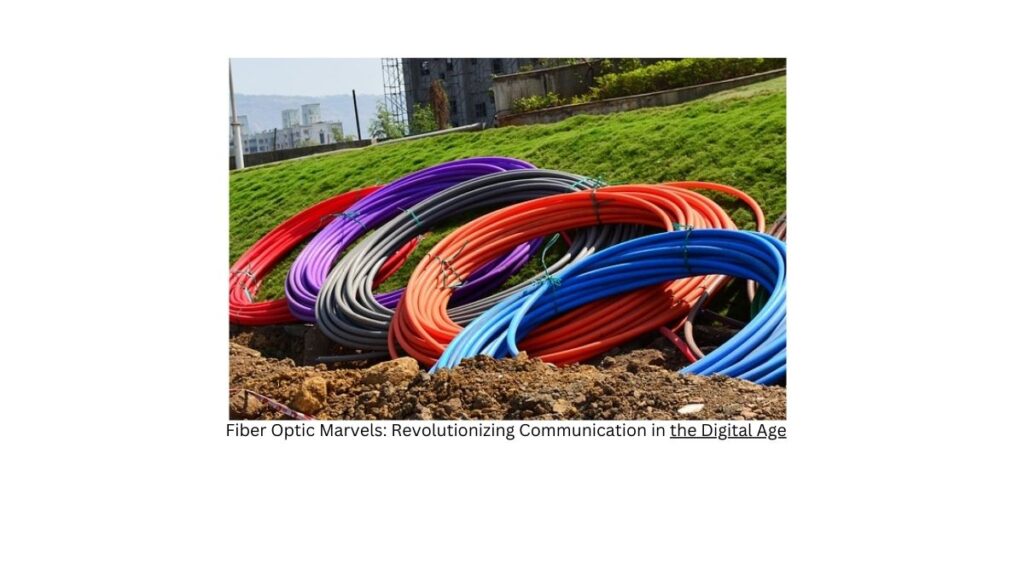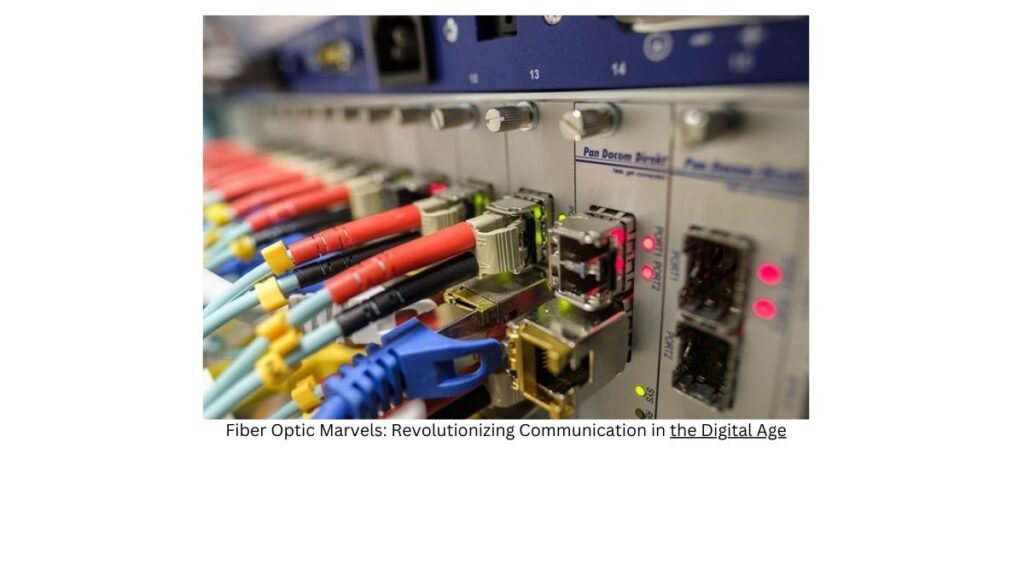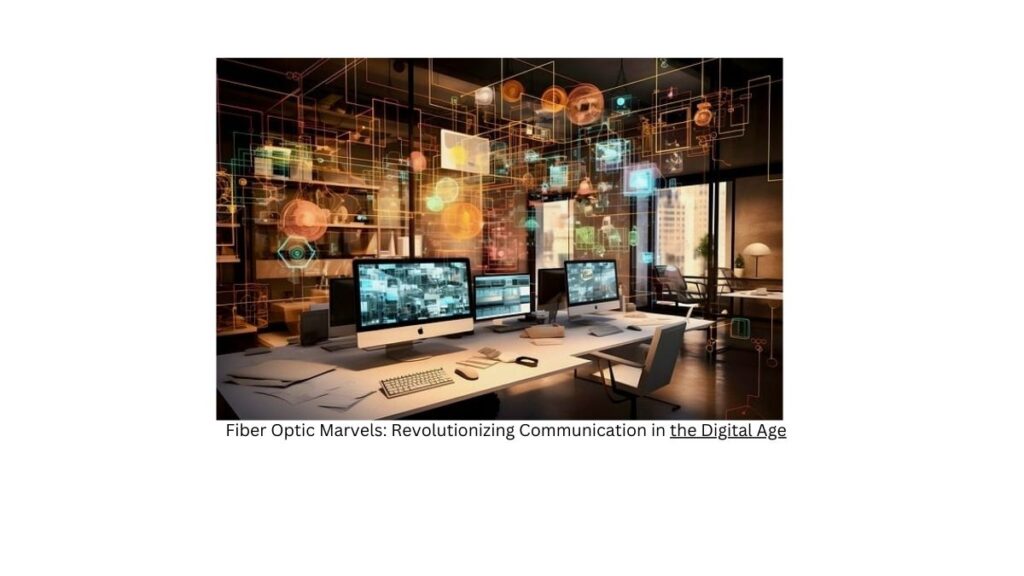Introduction:-
Fiber Optic Marvels: Revolutionizing Communication in the Digital Age

In an era dominated by digital advancements, the role of fiber optic technology stands out as a revolutionary force transforming the way we communicate. The marvels of fiber optics are reshaping the landscape of connectivity, enabling faster, more reliable data transmission. Let’s delve into the intricacies of this technology and explore how it is revolutionizing communication in the digital age.
Understanding Fiber Optic Marvels: A Beacon of Light
At its core, fiber optic technology revolves around the transmission of data through light pulses. Unlike traditional copper cables, which transmit electrical signals, fiber optics use light to carry information. This fundamental shift in the mode of transmission brings with it a host of advantages that are propelling fiber optics to the forefront of modern communication.

Unprecedented Speeds and Bandwidth
One of the most significant benefits of fiber optic technology is its ability to transmit data at unparalleled speeds. The use of light enables information to travel nearly at the speed of light itself, resulting in faster and more efficient communication. This high-speed capability is a game-changer for industries and individuals alike, as it facilitates seamless video streaming, rapid file downloads, and virtually lag-free online experiences.
In addition to speed, fiber optics boast an impressive bandwidth capacity. This means they can carry a vast amount of data simultaneously without compromising performance. As our digital interactions become more data-intensive, from high-definition video conferencing to virtual reality experiences, the expansive bandwidth of fiber optics proves essential in meeting the growing demands of the digital age.
Reliability and Signal Integrity
Fiber optic cables are renowned for their reliability and signal integrity. Traditional copper cables are susceptible to electromagnetic interference, which can degrade signal quality over long distances. Fiber optics, on the other hand, are immune to such interference, ensuring that data reaches its destination with minimal loss or distortion.
This reliability makes fiber optic technology especially crucial in mission-critical applications such as telecommunications, where maintaining a consistent and high-quality signal is paramount. The resilience of fiber optics contributes to enhanced communication stability, making it an ideal choice for businesses, service providers, and individuals seeking a dependable connectivity solution.
Empowering Connectivity Across Distances
The reach of fiber optic technology extends across vast distances without compromising performance. Unlike copper cables that experience signal degradation over long distances, light signals in fiber optics can travel for extended lengths without loss of quality. This property makes fiber optics indispensable for long-haul communication, connecting regions, countries, and continents seamlessly.
The global network infrastructure heavily relies on fiber optics to facilitate international communication and data exchange. From undersea cables carrying data between continents to high-speed fiber optic networks spanning entire countries, the technology plays a pivotal role in creating a connected world.
Applications Beyond Communication
While the primary focus of fiber optics is communication, its applications extend beyond transmitting data. Fiber optic sensors, for instance, are employed in various industries for monitoring and detecting changes in temperature, pressure, and other environmental factors. These sensors leverage the flexibility and sensitivity of fiber optics to provide real-time data for applications ranging from healthcare to industrial processes.
Moreover, the use of fiber optics in medical procedures has become increasingly prevalent. Fiber optic cables enable minimally invasive surgeries by transmitting light and images through small, flexible cables, reducing the need for large incisions. This application showcases the versatility of fiber optic technology in diverse fields beyond traditional communication.
Environmental Advantages and Sustainability
As the world becomes more conscious of environmental sustainability, fiber optic technology emerges as an eco-friendly alternative. Compared to traditional copper cables, manufacturing and maintaining fiber optics have a lower environmental impact. Fiber optic cables are not only lighter and smaller but also require fewer resources to produce, contributing to a more sustainable approach to connectivity infrastructure.
Additionally, the energy efficiency of fiber optics is notable. The transmission of data through light pulses consumes less power compared to the electrical signals in copper cables. As energy conservation becomes a crucial consideration in technological advancements, the eco-friendly profile of fiber optic technology aligns with the global push toward sustainable practices.
The Future of Fiber Optics: A Glimpse Ahead
As we stand at the precipice of the future, the trajectory of fiber optic technology points toward continued innovation and expansion. The ongoing development of advanced materials and manufacturing techniques promises even higher data transmission speeds and increased efficiency.
The integration of fiber optics into 5G networks is a significant stride towards the future of communication. The combination of high-speed, low-latency connectivity provided by fiber optics with the widespread coverage and capacity of 5G networks sets the stage for a hyper-connected world where smart devices, autonomous vehicles, and the Internet of Things (IoT) thrive.
What are fiber optics mainly used for?
Fiber optics are primarily used for high-speed data transmission in various communication and networking applications. Some of the main uses of fiber optics include:

- Telecommunications Networks:
- Long-Distance Communication: Fiber optics are widely used in long-haul communication networks, including undersea cables and terrestrial backbone networks. The high bandwidth and low signal loss of fiber optics make them ideal for transmitting data over long distances.
- Internet Service Providers (ISPs): Fiber optic cables are used by ISPs to deliver high-speed internet connections to businesses and homes. Fiber-to-the-Home (FTTH) or Fiber-to-the-Premises (FTTP) installations provide faster and more reliable internet services compared to traditional copper-based connections.
- Local Area Networks (LANs) and Wide Area Networks (WANs):
- Enterprise Networks: Many businesses and organizations use fiber optics for their internal networks. Fiber optic cables support high data transfer rates and are less susceptible to electromagnetic interference, making them suitable for demanding enterprise applications.
- Campus Networks: Fiber optics are often employed in large campus environments, such as universities or corporate campuses, to connect buildings and facilitate high-speed data transfer between different locations.
- Data Centers:
- High-Speed Data Transfer: Fiber optic cables are crucial in data centers where large volumes of data need to be transferred rapidly between servers and storage devices. Fiber optics help meet the bandwidth requirements of modern data-intensive applications.
- Reduced Latency: The low latency of fiber optics is essential for applications like cloud computing, where quick access to data and services is critical.
- Telephony and Voice Over Internet Protocol (VoIP):
- Voice Transmission: Fiber optics are used for voice communication in telephony and VoIP systems. They provide clear and reliable transmission of voice signals, ensuring high-quality communication.
- Cable Television (CATV):
- High-Definition Video Transmission: Fiber optics are employed in cable television networks to transmit high-definition video signals. Fiber optic cables can carry a large amount of data, making them suitable for delivering high-quality video content to subscribers.
- Medical Applications:
- Medical Imaging: Fiber optics play a role in medical imaging devices such as endoscopes. The flexibility and small size of fiber optic cables make them suitable for transmitting light and images in minimally invasive surgical procedures.
- Military and Aerospace:
- Secure Communication: Fiber optics are used in military and aerospace applications for secure and high-bandwidth communication. The immunity of fiber optics to electromagnetic interference makes them valuable in environments where electronic warfare may be a concern.
- Industrial Sensing and Automation:
- Sensors: Fiber optic sensors are utilized in industrial settings to monitor parameters like temperature, pressure, and strain. These sensors are immune to electrical interference and can be used in harsh environments.
- Research and Development:
- Scientific Instrumentation: Fiber optics find applications in scientific research instruments, such as spectroscopy and microscopy systems, where precise light transmission is crucial.
- Home Entertainment:
- High-Definition Television (HDTV): Fiber optics can be used to transmit high-definition video and audio signals in home entertainment systems, providing an immersive and high-quality viewing experience.
In summary, fiber optics are versatile and essential in various industries, providing a reliable and efficient means of transmitting data over short and long distances with high bandwidth and low signal loss.
Conclusion: Embracing the Fiber Optic Revolution
In conclusion, the marvels of fiber optic technology are undeniably revolutionizing communication in the digital age. From its unprecedented speed and bandwidth to its reliability, versatility, and environmental advantages, fiber optics have become the backbone of modern connectivity. As we navigate the complexities of an increasingly interconnected world, the significance of fiber optic technology will only continue to grow, shaping the way we communicate, innovate, and experience the digital realm. Embracing this revolution is not just a choice; it’s a necessity for staying at the forefront of a fast-paced and ever-evolving technological landscape.





